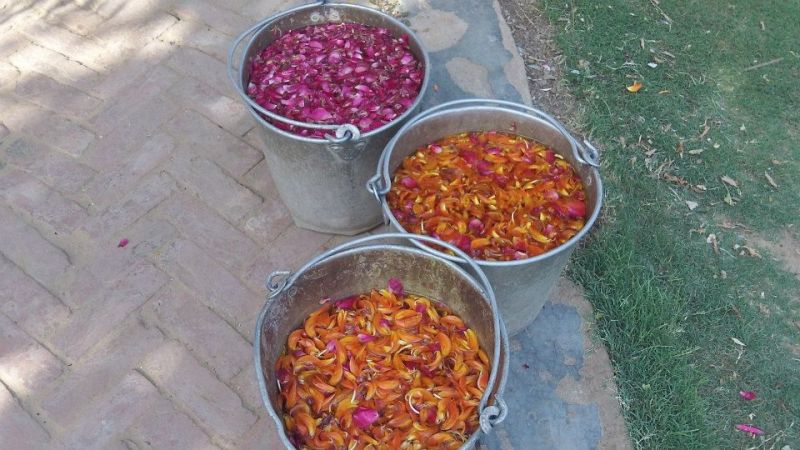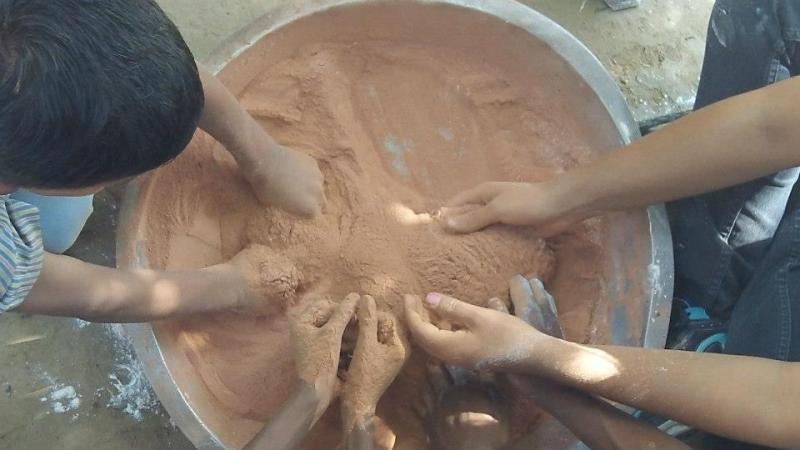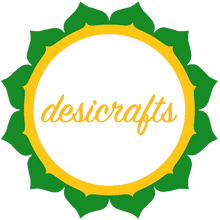In today’s world where we are struggling with issues like environmental pollution, fear of chemical hazards, threatening effects of global warming vegetable dyes and colors are gaining their popularity for they are pure and organic and they have absolutely no side effects on us or the environment.
Many people wonder why vegetable dyed fabrics and other items are more beautiful, popular and costlier than the regular products available in the market today. The reason is that it takes long time and great effort to prepare vegetable dyes. All vegetable colors are made using minerals, leaves, flowers and bark of various trees. Most common among them are:
Red
A solution of alum and tamarind seed powder is used to make red or rust color. Tamarind seed powder is boiled till it mixes well with the water and then it is left in the fiber or plastic vessles to cool down and come back to the normal temperature. The solution is then filtered using fine weave mulmul cloth (muslin) to avoide any particles and dust that may leave the color unusable. Less viscous solution is made to obtain deep red color while using the solution with high viscosity will give Rust color on the motif. If the printer has to make a very fine printing, he would prefer a rather thick solution as thin solution tend to drip and it may spoil the whole motif. Alum works as the color fixer for the solution.
Black
Iron ore is used to make the black dye. The ore is powdered and boiled to make a solution. Process of cooling and filtering is involved while making all vegetable dyes. When the dye is ready, it is directly applied onto the pattern using a pen or a wooden block.
Violet
Natural Indigo crystals are powdered and boiled to make a solution. The outcome of the color totally depends on the amount of the Indigo use while making the solution. It also depends on the viscosity of the solution. If one is making mauve color, one should use Indigo in lesser amount. Professional Dye makers weigh their contents before making the dye. It helps them obtaining exactly same color as they used for printing last time.
Yellow
Turmeric and Harad is used to make Yellow, Mustard, Lemon Yellow and other tints and shades of Yellow. In olden days, saffron was used to make yellow and Orange colors, now a days due to limited availability and high price, dyers prefer turmeric over the saffron.
Orange / Red
Flower from the tree of Palash (scientific name Butea monosperma) is used to make vegetable dye color. In India, Palash flower is also used for making colors for playing Holi (a festival in north India).
The Process
Obtaining colors from flowers is a long and tiring process. It takes from days to weeks to prepare good color in significant amount. To make dyes from flowers, the flowers are picked and petals are separated from rest of the flower, now the petals are left in hot (read warm) water(not boiling).

Flower petals are soaked in a bucket full of water before making color
The petals then start releasing the color and you can say so when you see the color of the water in the bucket changing.This is the right time to take the petals out for grinding.

Selective collection of flower petals for making vegetable color
Wet petals are finely ground and left in the shade for drying. This ground paste is not kept directly under the sun as harsh sun can take away the color of the paste leaving the useless, colorless chips of the dried paste behind.When the paste is dried, another round grinding is required.

The wet petals are then crushed finely and dried under shade before following another round of grinding
The powder is then filtered using a fine muslin cloth. It gives the finest powder color. Rest of the powder which still has big and small pieces in it, is grounded until it turns into fine powder. Now the powder color is ready, it is used as a solution with alum for printing fabrics, as and when required.

Kids in an Indian NGO “KarmMarg” are preparing vegetable colors for playing Holi
Which flower is used to obtain what color:
- Red Rose for Red, Pink Fuchsia and magenta.
- Palaash for Red, Orange, Yellow.
- Hibiscus for Red, Rust.
- Bark of Hibiscus tree for Brown, Beige and Rust.
- Lavender and Indigo for Blue, Mauve, Purple and Indigo.
and many other colors are made using different combinations!
Image credits – Delhi based NGO KarmMarg.

Comments
I wish make edible color in powder and gel form kindly send the information of ingredients to make powder or gel details process, machinary required, license need.
My self Naveen Kumar, working with propoor women SHG in latehar district of jharkhand facilated by DHAN FOUNDATION madurai tamilnadu. Actually here butea monosperma is more. We all women want to bring the organic way colouration. So please help us for the process for a bigger quantum.
Thanks
Hot damn, loionkg pretty useful buddy.
Dear Katherine,
Yes, indeed! Holi is a lovely celebration :) Thank you so much for your kind words! Please keep visiting.
Regards!
Hello, how beautiful is this story about making colors!!! I have learned about the festival of Holi in my past. Lovely celebration. I love your fabrics and am very impressed. So wonderful. Thank you very much.